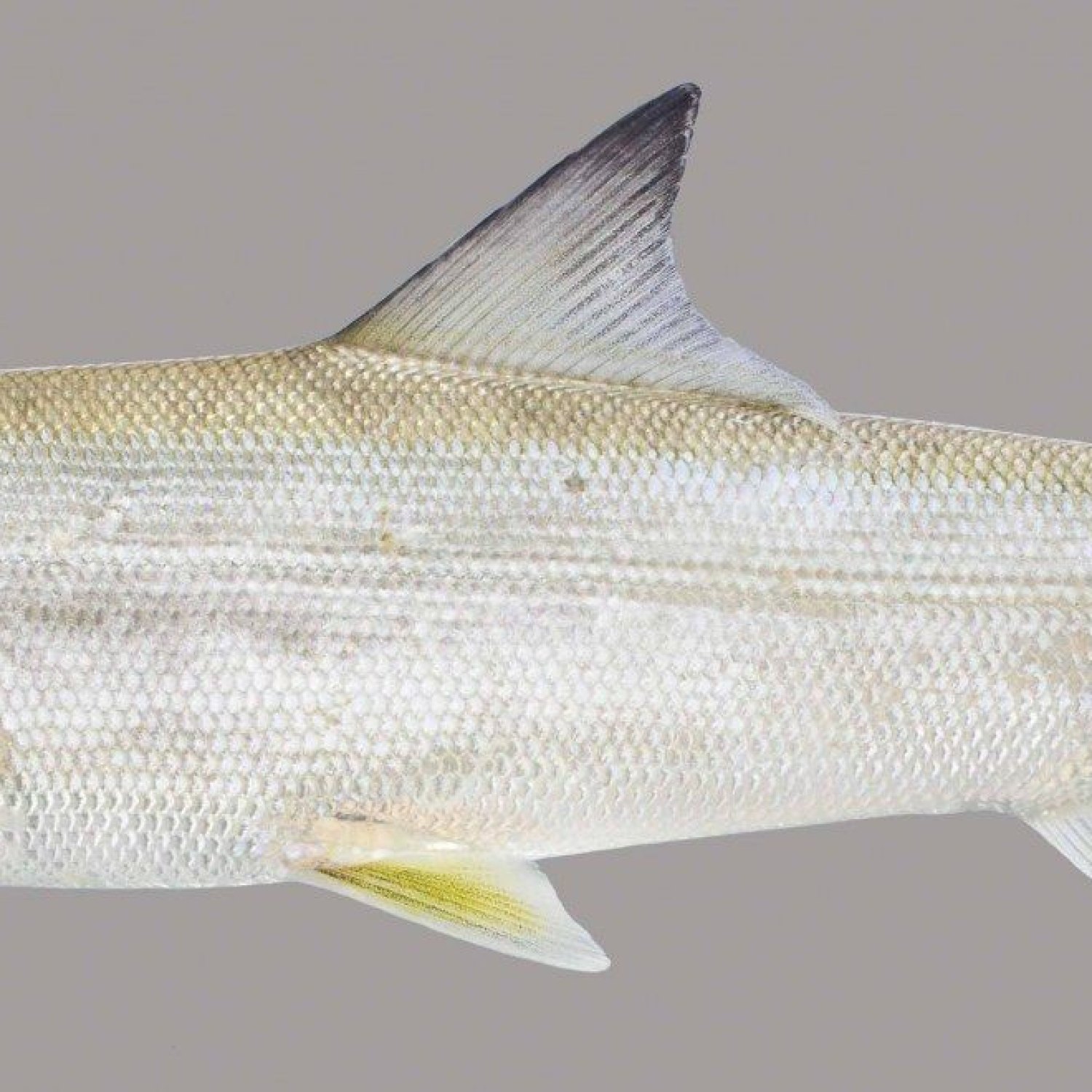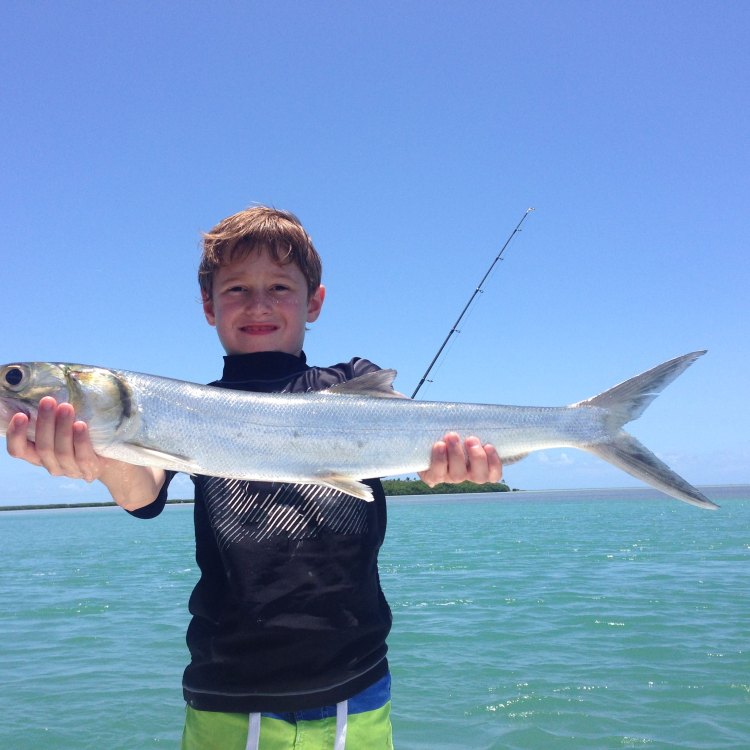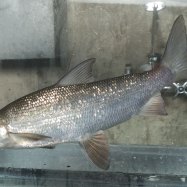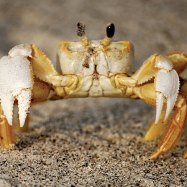
Ladyfish
Ladyfish can grow up to 3 feet in length, although they are typically around 2 feet long.
Did you know? Ladyfish, a member of the Elopidae family, can grow up to 3 feet in length and are commonly found in warm coastal waters. With their long and slender body shape and forked tail fin, they are able to swim quickly through the water. #animals #ladyfish #coastal #estuaries
Animal Details Summary:
Common Name: Ladyfish
Kingdom: Animalia
Habitat: Ladyfish are found in both saltwater and brackish water habitats. They prefer shallow coastal waters including bays, estuaries, and lagoons. They are also known to enter freshwater rivers and can tolerate a wide range of salinities.
Ladyfish: Experts of the Coastal Waters
Life in the ocean is a constant struggle for survival. From dodging predators to finding food, marine animals have evolved unique characteristics to thrive in their environment. One such species is the ladyfish, also known as Elops saurus in the scientific community. These stunning creatures are found in warm coastal waters around the world and are admired for their speed, agility, and remarkable adaptations Ladyfish. In this article, we will take a deep dive into the world of ladyfish and explore what makes them one of the most fascinating fish species.An Overview of the Ladyfish
The ladyfish belongs to the Animalia kingdom, Chordata phylum, and Actinopterygii class. They are classified under the order Elopiformes and the family Elopidae. Ladyfish are known by various names including bonefish, tenpounder, and banana fish. They are highly adapted for life in the water with streamlined bodies and powerful caudal fins that help them swim effortlessly.Habitat and Distribution
One of the most intriguing aspects of ladyfish is their adaptability to various habitats. These fish are found in both saltwater and brackish water habitats, preferring shallow coastal waters such as bays, estuaries, and lagoons. They are also known to enter freshwater rivers and can tolerate a wide range of salinities. This makes them a resilient species, able to survive in changing environments Leaf Tailed Gecko.When it comes to geographical distribution, ladyfish can be found in warm coastal waters around the world. They are commonly found in the Atlantic Ocean, Gulf of Mexico, and the Caribbean Sea. In the eastern hemisphere, they can be found in the Indian Ocean, the Pacific Ocean, and the Mediterranean Sea. This wide distribution contributes to their importance in marine ecosystems.
Feeding and Adaptations
Ladyfish are primarily piscivorous, meaning they feed on other fish species. Their diet consists mainly of small fish, crustaceans, and shrimp. Some of their favorite prey includes mullet, anchovies, and menhaden. They are also known to leap out of the water to catch insects and other flying creatures near the surface.To catch their prey, ladyfish have evolved impressive adaptations. Their streamlined body shape allows them to swim at high speeds, while their forked caudal fin provides stability and maneuverability. They also have sharp, pointed teeth to hold onto their prey and a protruding lower jaw, giving them a ferocious appearance. These creatures are highly skilled hunters, and their adaptability makes them a crucial part of the food chain.
Appearance and Physical Characteristics
Ladyfish have a striking appearance with a silvery coloration on their sides and a bluish-greenish back. They have a streamlined body shape with a long and slender body, similar to their close relatives, the tarpon and bonefish. One of their distinctive features is their deeply forked caudal fin, which helps them swim at high speeds in the water.They can grow up to 3 feet in length, although they are typically around 2 feet long. Their average weight ranges from 3 to 8 pounds, with the largest recorded ladyfish weighing around 16 pounds. They have a long, pointed head and a protruding lower jaw, giving them a unique appearance.
Ladyfish in Different Countries
Ladyfish can be found in various countries, making them a popular species to fishermen and researchers alike. In the United States, they are commonly found in the Gulf of Mexico and along the Atlantic coast from Florida to North Carolina. They are also found in Mexico, Brazil, and other countries in South America. In the eastern hemisphere, they can be found in India, Australia, and many other coastal countries.Despite their wide distribution, ladyfish are often targeted by commercial fisheries in some regions, threatening their populations. In the United States, they are not considered a game fish and are often caught incidentally while targeting other species. However, in Mexico and other South American countries, ladyfish are prized for their firm, white flesh, and are a popular food fish.
The Importance of Ladyfish in Marine Ecosystems
Ladyfish play an essential role in marine ecosystems, especially in shallow coastal waters. As predators, they help to control populations of smaller fish and maintain the balance of the food chain. They are also a vital food source for larger fish, birds, and marine mammals. In addition, their ability to tolerate various salinities and swim in different water depths makes them an important indicator species for environmental changes.Threats to Ladyfish Populations
Despite their importance in marine ecosystems, ladyfish populations face numerous threats. As mentioned earlier, commercial fisheries in some regions target them, and their populations can quickly decline due to overfishing. They are also vulnerable to habitat destruction, pollution, and climate change. In some areas, they are exposed to harmful algal blooms and suffer from diseases, which can negatively impact their populations.Conservation Efforts
To protect ladyfish populations, conservation efforts are essential. In the United States, the National Marine Fisheries Service has implemented strict regulations to control fishing activities and protect ladyfish populations. They are also focusing on monitoring the health of ladyfish populations and understanding their role in marine ecosystems. In other regions, efforts are being made to reduce pollution and protect their habitats from degradation.The Future of Ladyfish
Ladyfish are remarkable creatures that have been around for millions of years. Their adaptability and impressive physical characteristics make them a fascinating species to study. However, their populations are under threat, and it is crucial to take necessary steps to protect them. By understanding their biology and their role in marine ecosystems, we can ensure the survival of these magnificent fish for generations to come.In conclusion, ladyfish are more than just a beautiful sight in the coastal waters. They are an essential part of marine ecosystems, playing a crucial role in maintaining the balance of the food chain. Their adaptability, agility, and remarkable hunting skills make them a top predator in their habitat. As we continue to learn more about these creatures, let us also remember the importance of conservation efforts to protect their populations and the delicate ecosystems they call home.

Ladyfish
Animal Details Ladyfish - Scientific Name: Elops saurus
- Category: Animals L
- Scientific Name: Elops saurus
- Common Name: Ladyfish
- Kingdom: Animalia
- Phylum: Chordata
- Class: Actinopterygii
- Order: Elopiformes
- Family: Elopidae
- Habitat: Ladyfish are found in both saltwater and brackish water habitats. They prefer shallow coastal waters including bays, estuaries, and lagoons. They are also known to enter freshwater rivers and can tolerate a wide range of salinities.
- Feeding Method: Ladyfish are primarily piscivorous, meaning they feed on other fish species. Their diet consists mainly of small fish, crustaceans, and shrimp.
- Geographical Distribution: Ladyfish are found in warm coastal waters around the world. They are commonly found in the Atlantic Ocean, Gulf of Mexico, and the Caribbean Sea. They are also found in the Indian Ocean, the Pacific Ocean, and the Mediterranean Sea.
- Country of Origin: Ladyfish can be found in various countries including the United States, Mexico, Brazil, India, Australia, and many others.
- Location: Ladyfish are found in warm coastal waters and estuaries.
- Animal Coloration: Ladyfish have a silvery coloration on their sides and a bluish-greenish back. They have a streamlined body shape that helps them swim quickly in the water.
- Body Shape: Ladyfish have a long and slender body shape. They have a forked caudal fin (tail fin), which helps them swim fast in the water.
- Length: Ladyfish can grow up to 3 feet in length, although they are typically around 2 feet long.

Ladyfish
- Adult Size: Adult ladyfish can reach a maximum size of about 3 feet in length and weigh up to 15 pounds.
- Average Lifespan: The average lifespan of ladyfish is around 5-6 years.
- Reproduction: Ladyfish reproduce by spawning, where females release their eggs into the water and males fertilize them externally. They have pelagic eggs, meaning the eggs float in the water column.
- Reproductive Behavior: Ladyfish spawn in large groups, creating a dense cloud of eggs and sperm in the water. After spawning, the eggs hatch into larvae, which then develop into juvenile ladyfish.
- Sound or Call: Ladyfish do not produce any specific sounds or calls.
- Migration Pattern: Ladyfish are known to undertake seasonal migrations. They move between different habitats depending on factors such as water temperature, prey availability, and reproductive needs.
- Social Groups: Ladyfish are typically found in small groups or schools. They are known to exhibit aggregative behavior, where they gather in large numbers in specific areas during certain times of the year.
- Behavior: Ladyfish are highly active and fast-swimming fish. They are known for their acrobatic leaps out of the water, often while pursuing prey or evading predators. They are also known to be voracious feeders and are aggressive when it comes to feeding.
- Threats: The main threats to ladyfish include habitat loss, pollution, overfishing, and climate change. They are also vulnerable to predation by larger fish species and birds.
- Conservation Status: The conservation status of ladyfish is not currently assessed separately. However, they are listed as a species of least concern by the International Union for Conservation of Nature (IUCN).
- Impact on Ecosystem: Ladyfish play an important role in the ecosystem as both predator and prey. As predators, they help control the population of smaller fish species, maintaining the balance in the food chain. As prey, they provide food for larger fish, birds, and marine mammals.
- Human Use: Ladyfish are popular among recreational anglers due to their strong fighting ability and acrobatic behavior. They are also used as bait fish for other species. However, their flesh is not commonly consumed by humans.
- Distinctive Features: Some distinctive features of ladyfish include their elongated and slender body shape, silvery coloration, forked caudal fin, and overall streamlined appearance.
- Interesting Facts: 1. Ladyfish are excellent swimmers and can reach impressive speeds in the water. 2. Ladyfish are known for their acrobatic leaps out of the water, often reaching heights of several feet. 3. Ladyfish have been called the 'poor man's tarpon' due to their similar appearance and behavior to the larger tarpon species. 4. Ladyfish are sensitive to changes in water temperature and can be found in different depths depending on the season. 5. Ladyfish are often caught by anglers using live bait or artificial lures.
- Predator: Ladyfish are preyed upon by larger fish species such as tarpon, sharks, and barracuda. They are also targeted by seabirds such as ospreys and pelicans.

Elops saurus
The Fascinating World of Ladyfish: Unique Features and Role in the Ecosystem
When you think of fish, the first image that may come to mind is a typical, round-shaped fish with fins and scales. However, there are thousands of fish species in the world, each with its own unique features and characteristics.One such species is the ladyfish. With its sleek and slender body, silvery coloration, and acrobatic leaps, these fish have captured the interest and awe of people for centuries PeaceOfAnimals.Com. In this article, we will dive into the world of ladyfish and explore their distinctive features, behavior, and role in the ecosystem.
Distinctive Features
Ladyfish, also known as 'ten-pounder' or 'poor man's tarpon', are found in tropical and subtropical regions around the world. They belong to the family Elopidae, which includes ten species of fish. One of the distinctive features of ladyfish is their elongated and slim body shape, which can reach a maximum length of about 3 feet and weigh up to 15 pounds in adult individuals.
Their body is covered in shiny silver scales, giving them a beautiful and iridescent appearance. They have a forked caudal fin, also known as 'lunate' or 'moon' tail, which helps them swim at high speeds. Ladyfish also have a streamlined body shape, which allows them to move swiftly through the water, making them exceptional swimmers.
Reproduction and Behavior
Ladyfish reproduce by spawning, where females release their eggs into the water and males fertilize them externally. They have pelagic eggs, meaning the eggs float in the water column Lions Mane Jellyfish. Ladyfish spawn in large groups, creating a dense cloud of eggs and sperm in the water. After spawning, the eggs hatch into larvae, which then develop into juvenile ladyfish.
Female ladyfish can produce up to 100,000 eggs at a time, ensuring a higher chance of survival for the species. As for their behavior, ladyfish are highly active and fast-swimming fish. They are known for their acrobatic leaps out of the water, often while pursuing prey or evading predators. They are also voracious feeders and are aggressive when it comes to feeding.
Migration Pattern and Social Groups
Ladyfish are known to undertake seasonal migrations. They move between different habitats depending on factors such as water temperature, prey availability, and reproductive needs. These migrations can also happen due to changes in salinity levels and water quality.
In terms of social groups, ladyfish are typically found in small groups or schools. They are known to exhibit aggregative behavior, where they gather in large numbers in specific areas during certain times of the year. This behavior can be seen during spawning season or when prey fish are abundant in a particular location.
Threats and Conservation Status
Like many other marine species, ladyfish also face threats to their survival. Habitat loss, pollution, overfishing, and climate change are some of the main threats to the species. These threats can disrupt their reproductive and migratory patterns, as well as affect their food sources. Ladyfish are also vulnerable to predation by larger fish species and seabirds.
Currently, the conservation status of ladyfish is not assessed separately, but they are listed as a species of least concern by the International Union for Conservation of Nature (IUCN). However, it is crucial to monitor their populations and take necessary measures to protect them, as they play an important role in the marine ecosystem.
Impact on Ecosystem and Human Use
Ladyfish may not be a well-known or widely consumed fish by humans, but they play a crucial role in maintaining the balance in the marine ecosystem. As both predator and prey, they help control the population of smaller fish species, maintaining the food chain's equilibrium.
Their acrobatic leaps and swift movements also make them popular among recreational anglers. They are known for their strong fighting abilities and are often caught using live bait or artificial lures. Ladyfish are also used as bait fish for other species such as tarpon and snook.
Interesting Facts
1. Ladyfish possess an impressive swimming speed and can reach speeds of up to 40 mph.
2. Their acrobatic leaps can reach heights of several feet.
3. Ladyfish have been called the 'poor man's tarpon' due to their similar appearance and behavior to the larger tarpon species.
4. These fish are sensitive to changes in water temperature and can be found in different depths depending on the season.
5. Ladyfish are often caught by anglers using live bait or artificial lures.
Predators
As with most species, ladyfish have natural predators in their environment. Larger fish species such as tarpon, sharks, and barracudas prey on ladyfish. They are also targeted by seabirds such as ospreys and pelicans.
In conclusion, ladyfish may not be the most well-known or talked-about fish species, but their unique features, behavior, and role in the ecosystem make them a fascinating creature. From their acrobatic leaps to their crucial role in the marine food chain, these fish have captured the interest of scientists, anglers, and marine enthusiasts alike. As we continue to learn more about these elusive fish, it is essential to protect their habitat and ensure their survival for future generations to come.

Ladyfish: Experts of the Coastal Waters
Disclaimer: The content provided is for informational purposes only. We cannot guarantee the accuracy of the information on this page 100%. All information provided here may change without prior notice.












